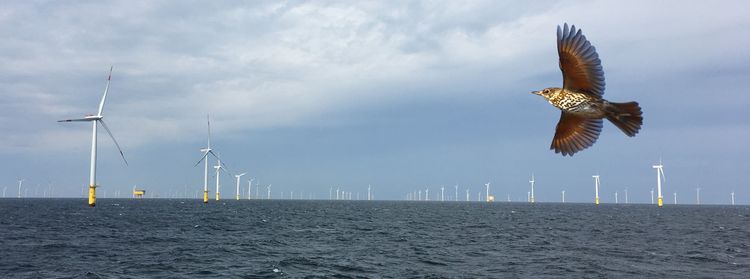Scientific Assistant


Offshore Migration
Effects of offshore wind power on bird migration in the North Sea and Baltic Sea – avoidance and species conservation measures

Each year, billions of songbirds migrate between their breeding grounds in northern Europe and their wintering grounds in southern Europe and Africa. During migration, they also cross offshore areas such as the North Sea. Since the mean flight altitude over sea is lower than over land, offshore wind turbines can pose a potential collision risk to birds. Unfortunately, we still know very little about how many songbirds, which species, and which populations actually fly over sea. Therefore, the focus of this study is the investigation of the small-scale flight paths and movement patterns of songbirds during migration at the coastline. The focus is on understanding the preferences for a flight over the sea and the associated environmental conditions. The aim is to clarify the species-specific proportion of birds that cross the North Sea compared to those that follow the coastline. For this purpose, wild songbirds are equipped with small and very light transmitters, which are attached like a backpack and fall off after a few weeks. These transmitters emit a specific radio signal, which can be received with specially built antennas at the North Sea coast (Motus wildlife tracking system, see motus.org/). In this way, the flight paths of the individual birds can be drawn relatively precisely both in terms of time and space. GPS technology, as we know it from navigation devices or mobile phones, is still far too heavy for small songbirds. The flight paths can be used to estimate what proportion of the population flies over sea and could therefore be in conflict with offshore wind power. The environmental conditions (e.g. wind speed and direction, precipitation, changes in air pressure) that motivate birds to fly over the sea can also be analysed. A second part of this collaborative project, which deals with large birds from geese over seabirds to waders, is located at the Research and Technology Centre, West Coast (FTZ) of the University of Kiel. Ultimately, these findings serve information to create effective avoidance and species support measures in order to keep the effects of the expansion of renewable energies on birds as low as possible.
This project builds on the BIRDMOVE (2016-2019) and TRACKBIRD (2019-2023) projects, which were carried out by the Institute of Avian Research "Vogelwarte Helgoland" by Dr. Ommo Hüppop and also from the Research and Technology Centre, West Coast. This and the previous projects were funded by the Federal Agency for Nature Conservation (BfN) with funds by the Federal Ministry for the Environment, Nature Conservation, Nuclear Safety and Consumer Protection (project website: www.natur-und-erneuerbare.de/projekt-database/trackbird-vogelzug-ueber-nord-und-ostsee-und-offshore-wind energy)
Project-related Publications
Klinner, T.*, Karwinkel, T.*, Packmor, F., & Schmaljohann, H. (2025). Stopover departure decisions in spring: pre-Saharan migrants stay longer and are more selective for favourable wind than trans-Saharan migrants. Movement Ecology, 13(1), 64. https://doi.org/10.1186/s40462-025-00575-0
*shared first authorship
Mitchell, L., Brust, V., Karwinkel, T., Åkesson, S., Kishkinev, D., Norevik, G., Szep, T., Hedenström, A., Lagerveld, S., Helm, B., & Schmaljohann, H. (2025). Conservation-focused mapping of avian migratory routes using a pan-European automated telemetry network. Conservation Biology, e70017. https://doi.org/10.1111/cobi.70017
Walsh C, Hüppop O, Karwinkel T, Liedvogel M, Lindecke O, McLaren JD, Schmaljohann H & Siebenhüner B (2025). Marine artificial light at night: Implications and potential hazards for offshore songbird and bat movements in the Greater North Sea. Conservation Science and Practice, e70008. https://doi.org/10.1111/csp2.70008
Rüppel G, Hüppop O, Schmaljohann H, Brust V (2023b) The urge to breed early: Similar responses to environmental conditions in short- and long-distance migrants during spring migration. Ecology and Evolution, 13(7), e10223. doi.org/10.1002/ece3.10223
Rüppel G, Hüppop O, Lagerveld S, Schmaljohann H, Brust V (2023a) Departure, routing and landing decisions of long-distance migratory songbirds in relation to weather. Royal Society Open Science, 10(2), 221420. doi.org/10.1098/rsos.221420
Eikenaar C, Ostolani A, Brust V, Karwinkel T, Schmaljohann H, Isaksson C (2023) The oxidative balance and stopover departure decisions in a medium-and a long-distance migrant. Movement Ecology, 11(1), 7. doi.org/10.1186/s40462-023-00372-7
Brust V, Schmaljohann H, Hüppop O (2022) Two subspecies of a songbird migrant optimise departure from a coastal stopover with regard to weather and the route lying ahead. Journal of Avian Biology e03004. doi.org/10.1111/jav.03004
Brust V, Eikenaar C, Packmor F, Schmaljohann H, Hüppop O, Czirják G (2022) Do departure and flight route decisions correlate with immune parameters in migratory songbirds? Functional Ecology 36: 3007– 3021. doi.org/10.1111/1365-2435.14187
Bach P, Voigt C C, Göttsche M, Bach L, Brust V, Hill R, Hüppop O, Lagerveld S, Schmaljohann H, Seebens‐Hoyer A (2022) Offshore and coastline migration of radio‐tagged Nathusius' pipistrelles. Conservation Science and Practice, 4(10), e12783. doi.org/10.1111/csp2.12783
Brust V, Hüppop O (2021) Underestimated scale of songbird offshore migration across the south-eastern North Sea during autumn. Journal of Ornithology, 1-10. doi.org/10.1007/s10336-021-01934-5
Michalik B, Brust V, Hüppop O (2020) Are movements of daytime and nighttime passerine migrants as different as day and night? Ecology and Evolution 00: 1-12, doi.org/10.1002/ece3.6704
Brust V, Michalik B, Hüppop O (2019) To cross or not to cross – thrushes at the German North Sea coast adapt flight and routing to wind conditions in autumn, Movement Ecology 7:32, doi.org/10.1186/s40462-019-0173-5
Brust V, Michalik B & Hüppop O (2018) Individuelle Flugwege kleiner Singvögel zur Zugzeit an der Deutschen Bucht. Vogelwarte 56, 367, doi.org/10.1186/s40462-019-0173-5


